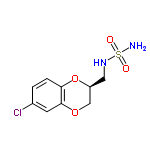JNJ-26489112
Appearance
 | |
| Identifiers | |
|---|---|
| |
| CAS Number | |
| PubChem CID | |
| ChemSpider | |
| UNII | |
| CompTox Dashboard (EPA) | |
| Chemical and physical data | |
| Formula | C9H11ClN2O4S |
| Molar mass | 278.71 g·mol−1 |
| 3D model (JSmol) | |
| |
| |
JNJ-26489112 is an anticonvulsant drug being developed by Johnson & Johnson for the treatment of epilepsy.[1][2][3] JNJ-26489112 was designed as a successor to topiramate.[4] It is expected to have fewer side effects than topiramate because it lacks activity against carbonic anhydrase.[4]
JNJ-26489112 was studied as a treatment for major depressive disorder.[5] This clinical trial was terminated in 2013 due to a "sponsor portfolio decision", and no new development of JNJ-26489112 has been reported.
Its mechanism of action is unknown.[6]
See also
References
- ^ Trenité DK, Diprospero NA, Moyer JA, Gambale J, Pandina G, Ford L, Girgis S, Xi L, Nye J (August 2013). "Evaluation of JNJ-26489112, a Novel Antiepileptic Drug: A Placebo-Controlled, Exploratory Study". Clinical Therapeutics. 35 (8): e70. doi:10.1016/j.clinthera.2013.07.204.
- ^ Clinical trial number NCT00579384 for "A Study of the Effects of JNJ-26489112 on the Photic Induced Paroxysmal Electroencephalogram Response in Patients With Photosensitive Epilepsy" at ClinicalTrials.gov
- ^ Di Prospero NA, Gambale JJ, Pandina G, Ford L, Girgis S, Moyer JA, et al. (May 2014). "Evaluation of JNJ-26489112 in patients with photosensitive epilepsy: a placebo-controlled, exploratory study". Epilepsy Research. 108 (4): 709–16. doi:10.1016/j.eplepsyres.2014.01.018. PMID 24560845. S2CID 25545178.
- ^ a b McComsey DF, Smith-Swintosky VL, Parker MH, Brenneman DE, Malatynska E, White HS, et al. (November 2013). "Novel, broad-spectrum anticonvulsants containing a sulfamide group: pharmacological properties of (S)-N-[(6-chloro-2,3-dihydrobenzo[1,4]dioxin-2-yl)methyl]sulfamide (JNJ-26489112)". Journal of Medicinal Chemistry. 56 (22): 9019–30. doi:10.1021/jm400894u. PMC 4004761. PMID 24205976.
- ^ Clinical trial number NCT01114698 for "A Safety and Efficacy Study of JNJ26489112 in Patients With Treatment-Resistant Major Depressive Disorder" at ClinicalTrials.gov
- ^ Zaccara G, Schmidt D (February 2016). "Do traditional anti-seizure drugs have a future? A review of potential anti-seizure drugs in clinical development". Pharmacological Research. 104: 38–48. doi:10.1016/j.phrs.2015.12.011. PMID 26689774.
Further reading
- Toxicological study of JNJ-26489112: Eichenbaum G, Zhou J, Kelley MF, Roosen W, Costa-Giomi P, Louden C, et al. (July 2014). "Implications of retinal effects observed in chronic toxicity studies on the clinical development of a CNS-active drug candidate". Regulatory Toxicology and Pharmacology. 69 (2): 187–200. doi:10.1016/j.yrtph.2014.03.005. PMID 24680767.
